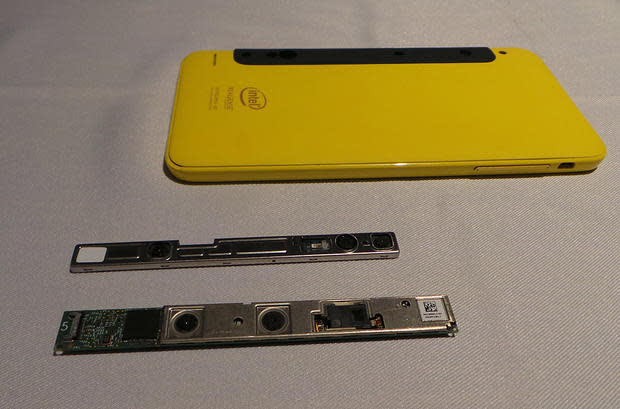Intel wants RealSense off the desktop and onto 'anything'
This article, Intel wants RealSense off the desktop and onto 'anything', originally appeared on CNET.com.

Intel's Kirk Skaugen holds up a RealSense module at Computex 2015. Nic Healey/CNET
TAIPEI -- Intel's RealSense 3D camera might just be gaining popularity on the new models of PCs, laptops and tablets hitting the market, but the company has far bigger plans for the multi-lens scanning, depth-sensing technology.
Intel first showed off RealSense for CES 2014 before throwing the gauntlet down to app developers at Computex the same year, offering $1 million in "cash and marketing" to get devs excited. The 3D scanning camera was even a big focus for Intel at CES this year, and finally we're getting some products out in the wild -- both Lenovo and Asus have launched PCs with RealSense built-in just in the past few days. It was even featured as part of an art installation during the Vivid Festival in Sydney Australia.
Intel has worked with Microsoft to ensure that Windows 10 will even offer a native facial recognition log-in option for any Windows device with a RealSense camera. Called Windows Hello, it lets you log in to your PC simply by sitting in front of it. Because the RealSense camera measures depth, it can't be spoofed by holding up a photo, and by using infra-red it works effectively even in low light scenarios. A newly acquired piece of software called True Key allows you to use the facial biometics for websites, phone banking and more.
Of course, Intel has shown off 3D scanning, gesture control and 'green-screen' style video-conferencing applications many times in the past.
The next step, according to RealSense Product Manager Anil Naduri is to get the technology into an even broader range of products. While Intel has previously shown off the camera in drones, it's currently mostly in tablets, laptops and desktops.
"The ultimate goal for RealSense is getting it off the desktop and into any device that can use it," says Naduri during an interview session at Computex 2015.

The Intel reference smartphone with RealSense/ Nic Healey/CNET
Naduri has a smartphone reference design, apparently called the Yellows II, which has RealSense built-in as the phone's camera. While he calls it a 'phablet', it's certainly no larger than many of the six-inch screen phones on the market. He didn't have much to say on the device -- there's certainly no firm plans for manufacturing or release -- but it's running Android 5.0.1 on an Intel platform. Later during the Intel keynote speech, Kirk Skaugen, senior vice president and general manager of Intel's Client Computing Group, showed off a different reference model, again with very little information.
Naduri explained that there are two hardware variants of the RealSense camera. One can analyse a depth of around one metre and it's this user-facing version that's most suited for desktop and laptop use.
The other world-facing module is suitable for both indoor and outdoor use, and according to Naduri it's this one that Intel wants in "robots and drones" as well as mobile devices. It has a depth of around four metres, but can actually get some 3D sense up to 10m.

The reference phone beside the two RealSense modules. Nic Healey/CNET
He showed a quick video of the latter model mounted on a car dash, clearly 3D mapping the road ahead in real time even travelling at 60mph (100kph), and stated that smart car technology is definitely one application for RealSense.
What could this do in a small form factor mobile device like a smartphone? Well, two quick practical demonstrations from Naduri had RealSense on a tablet immediately scanning the dimensions of two different size boxes, then analysing the best way for multiple amounts of them to be stacked for shipping. A similar app instantly and accurately measured the distance between any two points, simply by tapping on the screen.
All this is very much down the road for RealSense, which is still finding its feet in the marketplace. While Intel is committed to the technology and says it's an integral part of its vision for "natural user interfaces" in the future, Naduri admits that the immediate future for RealSense is a little more prosaic.
"The next big step is just getting it out there," he says. "Getting it into the ecosystem and ramping up usage. From there, it's all about richer capabilities, smaller modules and a more user-friendly interface."
Also from CNET:


